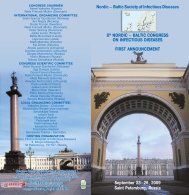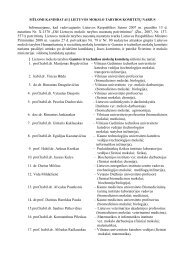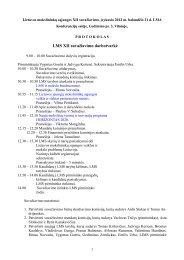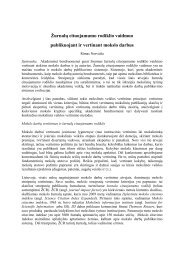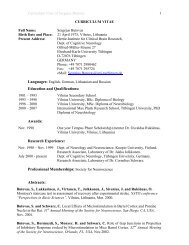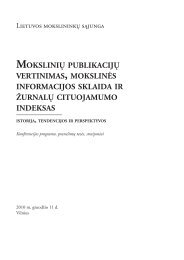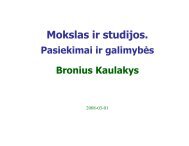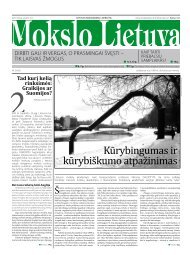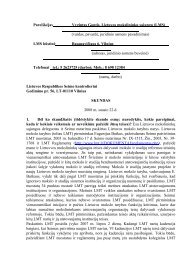In this book the development of the nature since the earliest geological stages of our planetand until the latest, Quaternary period, in Lithuania is characterized. Palaeogeography of Post Glacialand human settling in Lithuania territory are described also. Mythologization of the environment aswell as the power of giants and devils in Lithuanian legends is discussed. The conditions when thenature becomes the reason, source and object of the cultural activity of the man are considered. Usingthe results of geological, geographical and biological investigations as well as historical andmythological data and examples of the art (painting, poetry, prose and etc.) the valley of ŠventojiRiver in vicinities of Anykščiai Town, Šatrija Hill in Žemaitija, Juodkrantė Township in Curonian Spitwith the recourses of amber, The Great Lakes of Sūduva (Dusia, Metelys and Obelija) and Raigardasvalley near Druskininkai Town is told about.The great importance of the knowledge of the nature development for the word outlook of man isconsidered in the book. The author pays attention to biosphere doctrine (proceedings of V.Vernadsky), is in dispute with the opponents of nature evolution and discuses the importance of thenature inspirations for the art. Author takes up the position that scientific knowledge of thesurrounding environment together with other cultural values, inspired by nature (folklore, painting,poetry and etc.), creates that unique spiritual superstructure of nature, that supports saving the valuesof the nature as the result of centuries-old interaction between nature, man and culture for the futuregenerations. Unfortunately, this result can be different and not positive forever.ПРИРОДА КАК ИСТОЧНИК КУЛЬТУРЫ(анотация)В книге охарактеризована древняя природа Литвы, ее развитие от первыхгеологических этапов нашей планеты до последнего четвертичного (антропогенового) периода.Описаны палеогеография послеледниковья и заселение человеком территории Литвы.Обсуждена мифологизация окружающей среды, могущество великанов и чертей в литовскихпреданиях. На примере конкретных местностей Литвы рассмотрены условия, при которыхприрода становится причиной, источником и объектом культурной деятельности человека.Используя результаты геологических, географических, биологических, археологическихисследований, исторические и мифологические данные, примеры художественного творчества(живописи, поэзии, прозы и т. п.) рассказывается о долине реки Швянтойи вблизи городаАникщяй, горе Шатрия в Жямайтии, местечке Юодкранте со своими ресурсами янтаря вКуршской косе, Великих озерах Судувы (Дуся, Мятялис и Обялия) и долине Райгардас южнеегорода Друскининкай.В книге также рассматривается значение познания развития природы длямироощущения и мировоззрения человека. Большое внимание уделяется учению о биосфере(труды В. Вернадского), полемизируется с опонентами эволюции природы, обсуждаютсяприродные вднохновляющие ресурсы и их влияние на творчество в исскустве. Авторомзащищается позиция , что научное познание окружающей среды совместно с другими изприроды вышедшими ценностями культуры (фольклор, живопись, поэзия и др.) создают тууникальную духовную надстройку природы, которая помогает и будет помогать сберечьценности природы для будущих поколений как результат взаимодействия природы, человека икультуры. К сожалению, этот результат может быть разным и не всегда позитивным.ILIUSTRACIJŲ PAVADINIMAI KNYGAI ,,GAMTA KAIP KULTŪROS ŠALTINIS”)1 pav. Geologinė laiko skalė (<strong>Lietuvos</strong> geologija, 1994)152
2 pav. <strong>Lietuvos</strong> Žemės gelmių apibendrintas geologinis pjūvis iš vakarų į rytus (Uginčius, Baltrūnas,1999). Pjūvyje parodyti archėjaus ir proterozojaus (AR-PR), vendo (V), kambro (Є), ordoviko (O),silūro (S), devono (D), permo (P), triaso (T), juros (J), kreidos (K) ir kvartero (antropogeno) (Q)klodai3 pav. <strong>Lietuvos</strong> geologijos muziejus Vievyje (E.Gaižausko nuotrauka)4 pav. Taip saugomas gręžinių kernas (cilindrinis uolienų stulpelis) <strong>Lietuvos</strong> geologijos muziejauskerno saugykloje (E.Gaižausko nuotraukos)5a pav. Rodinijos superkontinento (prieš 750 mln. metų) rekonstrukcija (pagal Torsvik T. H. ir kt.,1996)5 pav. Mizarų astroblemos geografinė padėtis (a) ir pjūvis per ją (b) (Gailius, Motuza, 1977)Įvairių geologinių periodų uolienos: 1 – kvartero, 2 – paleogeno, 3, 4 – kreidos, 5 – triaso, 6 –viršutinio proterozojaus–kambro, 7 – archėjaus–proterozojaus, 8 – sutrupintų uolienų zona, 9 – lūžiaiŽemės plutoje, 10 – astroblemos kontūrai, 11 – gręžinio vietos, 12 – pjūvio linija6 pav. Būdingoji <strong>Lietuvos</strong> paleozojaus fauna (<strong>Lietuvos</strong> geologija, 1994)a – kambro trilobitas (T. Jankausko kolekcija), b – ordoviko vėžiagyviai (N. Sidaravičienės kolekcija),c – silūro graptolitai (J. Paškevičiaus kolekcija), d – silūro pečiakojai (P. Musteikio kolekcija), e –devono fosilijos, f – viršutinio permo fosilijos (P. Suveizdžio kolekcija): 1–3 – foraminiferai, 4, 5 –samangyviai, 6–8 – pečiakojai,7 pav. Baltijos baseino rytinės dalies viršutinio silūro facijos: a – ludlovio laikotarpis, b – ludloviolaikotarpio pabaiga (Pagėgių, Venspilio ir Sudervės svitų kraigo facijos) (<strong>Lietuvos</strong> geologija, 1994).A – giluminės atviros jūros facijos, susidariusios anaerobinėmis sąlygomis žemiau bangų veikimolygio: 1 – juodo graptolitinio molio; 2 – juodo ir žalsvai pilko graptolitinio molio; 3 – žalsvai pilko irjuodo molio su molingo karbonatinio dumblo tarpsluoksniais; 4 – žalsvai pilko molio ir molingokarbontinio dumblo; B – seklaus šelfo facijos, susidariusios aerobinėmis sąlygomis aukščiau bangųveikimo lygio: 1 – žalsvai pilko molingo karbonatinio dumblo; 2 – žalsvai pilko molingo karbonatiniodumblo su aleurito ir smėlio grūdeliais; 3 – raudono ir pilko molio it molingo karbonatinio irdolomitinio dumblo; 4 – pilko sluoksniuoto karbonatinio ir molingo karbonatinio dumblo; 5 – pilkogniutulinio karbonatinio dumblo; 6 – rifinės klinties; 7 – juodo molingo karbonatinio ir karbonatiniosu koralais dumblo; C – padidėjusio druskingumo lagūninės facijos: 1 – dolomitinio dumblo (Mituvossvitos, apačioje su onkolitais); 2 – sluoksniuoto dolomitinio molingo dumblo, dolomitinio raudono irpilko molio ir gipso facija; D – augalija ir gyvūnija: 1 – stromatoporoidėjos; 2, 3 – koralai: 2 –kolonijiniai, 3 – pavieniai; 4, 5 – pečiakojai: 4 – plonasieniai, 5 – storasieniai, 6–9 – moliuskai: 6 –plonasieniai dvigeldžiai, 7 – storasieniai dvigeldžiai, 8 – pilvakojai, 9 – galvakojai, 10 – trilobitai; 11– vėžiagyviai; 12 – stambūs vėžiagyviai (leperdicijos); 13 – eurypteridai; 14 – jūrų lelijos; 15, 16 –graptolitai: 15 – graptoloidėjos, 16 – dendroidėjos, 17 – konodontai; 18 – ichtiofauna; 19 – primityvūsaugalai8 pav. Vėlyvojo permo laikotarpio litologinis–paleogeografinis žemėlapis (<strong>Lietuvos</strong>geologija, 1994).1,2 – nepadengti permo nuosėdomis plotai:1 – paviršiuje kristalinės uolienos, 2 –nuosėdinės uolienos, 3–8 – viršutinio permo nuosėdų išplitimas: 3 – iki denudacijos, 4 –klintis, 5 – dumblių ir samangyvių rifai, 6 – susisluoksniavusios karbonatinės irsulfatinės uolienos (vyrauja pastarosios), 7 – tas pats su akmens druska (vyraujapastaroji), 8 – plonų kalio druskų sluoksnių išplitimas, 9 – išplitimo ribos: a – apytikslės(jūroje), b – po prekvartero nuosėdomis; 10 – nuosėdų storis, m: a – maksimalausišplitimo riba (nulinė izopachita), b – išlikusių nuosėdų izopachitos; 11: a – giliųjųtektoninių lūžių, turėjusių poveikį nuosėdų klostymuisi, vieta, b – facijų ribos; 12 –denuduojamos medžiagos nešimo kryptis153
- Page 1 and 2:
VALENTINAS BALTRŪNASGAMTA KAIP KUL
- Page 3 and 4:
V. Baltrūnas. Gamta kaip kultūros
- Page 5 and 6:
Į V A D A SGamtos ir kultūros są
- Page 7 and 8:
folklorinio ir profesionaliojo meno
- Page 9 and 10:
klausimu ir bent kelių vyraujanči
- Page 11 and 12:
suakmenėjusių fosilijų amžius P
- Page 13 and 14:
tik šiek tiek jaunesnė yra prie V
- Page 15 and 16:
pogonoforai, forominiferai, akritar
- Page 17 and 18:
anteklizė) kaip kalnodaros kituose
- Page 19 and 20:
terigeninių nuogulų (molio, aleur
- Page 22 and 23:
Didžiausias Lietuvoje neogeno nuog
- Page 24 and 25:
Dideles nuogulų storymes, paprasta
- Page 26 and 27:
Europos šiaurinės dalies nuosekli
- Page 28 and 29:
Šis skyrius yra tarsi ankstesniojo
- Page 30 and 31:
kalvos (19 pav.). Čia reikia pridu
- Page 32 and 33:
kituose kraštuose. Šiuo metu Liet
- Page 34 and 35:
pasaulėžiūroje ir kurie yra įpr
- Page 36 and 37:
Santykis su aplinka: praktinis aspe
- Page 38 and 39:
už 0,005 mm. Yra ir kitokių molio
- Page 40 and 41:
kita kryptimi. Deja, šiandieninė
- Page 42 and 43:
žmogiškojo kalvio kovos ir kalvys
- Page 44 and 45:
išraiškingesnė kraštovaizdžio
- Page 46 and 47:
estų tautosakoje, kitų tautų fol
- Page 48 and 49:
Naujojo akmens laikotarpiu jau lank
- Page 50 and 51:
mokslinės minties įkvėpėją. Pa
- Page 52 and 53:
pastraipoje rašoma: ,,Greitas mar
- Page 54 and 55:
Nepaprastai didelę Šventosios ir
- Page 56 and 57:
spėjamas alkavietės aukuras. Žmo
- Page 58 and 59:
padavimai apie vieną ar kitą būd
- Page 60 and 61:
Vidudienį paleido arklį ir atsigu
- Page 62 and 63:
nuosėdų). Ir tik juros periodo pa
- Page 64 and 65:
šiaurinių ir dalies vakarinių to
- Page 66 and 67:
sudeginti kaip raganas keturias mot
- Page 68 and 69:
vėjas, išsklaidęs po visą salą
- Page 70 and 71:
Baltijos ledyninio ežero metu (pri
- Page 72 and 73:
pabaigoje surado A. Becenbergeris,
- Page 74 and 75:
Tačiau pabaiga būdavo panaši. Gi
- Page 76 and 77:
angų, graibyti iš jūros dugno, o
- Page 78 and 79:
graikai galėjo ramiai plaukti toli
- Page 80 and 81:
poetas, savo akimis matė gimtojo k
- Page 82 and 83:
(46 pav.), R. Kalpoko ,,Kaimo gatv
- Page 84 and 85:
visuomet protu ir širdimi taps ind
- Page 86 and 87:
tai iš pietų į šiaurę besitęs
- Page 88 and 89:
ežeruose, paminimas faktas, kad Du
- Page 90 and 91:
udės (Aythya nyroca) perimvietė.
- Page 92 and 93:
smailiomis viršūnėmis, daugelis
- Page 94 and 95:
lipdytos keramikos grublėtu pavir
- Page 96 and 97:
nugrimzdusius mūrus yra gerokai v
- Page 98 and 99:
elaukiant Trejybės šventės prie
- Page 100 and 101:
darbai). Mūsų krašte žinoma nem
- Page 102 and 103: usvai pilkos ir rudos spalvos tanki
- Page 104 and 105: pakrantėje pasiekia 12 m. Su I vir
- Page 106 and 107: Džiūstantis II viršsalpinės ter
- Page 108 and 109: patikslintos viduramžių kapinaič
- Page 110 and 111: Tai V. Vėlyvio, M. Jankaus, S. Rud
- Page 112 and 113: ir pasitikint, jai lemta efemerišk
- Page 114 and 115: sudėties, fizinių savybių, papli
- Page 116 and 117: taip pat su savitu kai kurių termi
- Page 118 and 119: Pripažįstama, kad požeminė gyvy
- Page 120 and 121: Knyga baigiama skyriumi ,,Keli žod
- Page 122 and 123: E. Lekevičiaus mintis (Lekevičius
- Page 124 and 125: naudos. Ypač šiandien svarbu - mo
- Page 126 and 127: vadinamų ,,glacialistų” ir ,,ma
- Page 128 and 129: augalų, užgyvenusių sausžemius
- Page 130 and 131: ,,Tejaras sukūrė krikščionišk
- Page 132 and 133: įvykęs susiderinimas, susiformavi
- Page 134 and 135: apkaltinant ,,mitomanija” ir menk
- Page 136 and 137: istorinėje atmintyje fiksuotą žy
- Page 138 and 139: pėdos/šlaite ledynmečio kalvos
- Page 140 and 141: daug reiškia gimtoji jų žemės
- Page 142 and 143: žmogui gamta yra ne kas kita kaip
- Page 144 and 145: prigimtį, abejonių nekelia kultū
- Page 146 and 147: Ne visi gamtos objektai išraiškin
- Page 148 and 149: Jablonskis K. ir kt. Raganų teisma
- Page 150 and 151: Pranaitis A., Sinkevičius Ž., 200
- Page 154 and 155: 9 pav. Juros ir kreidos perioduose
- Page 156 and 157: 38 pav. Litorinos lagūninio gintar
- Page 158: 70 pav. M. K. Čiurlionis. Raigarda



